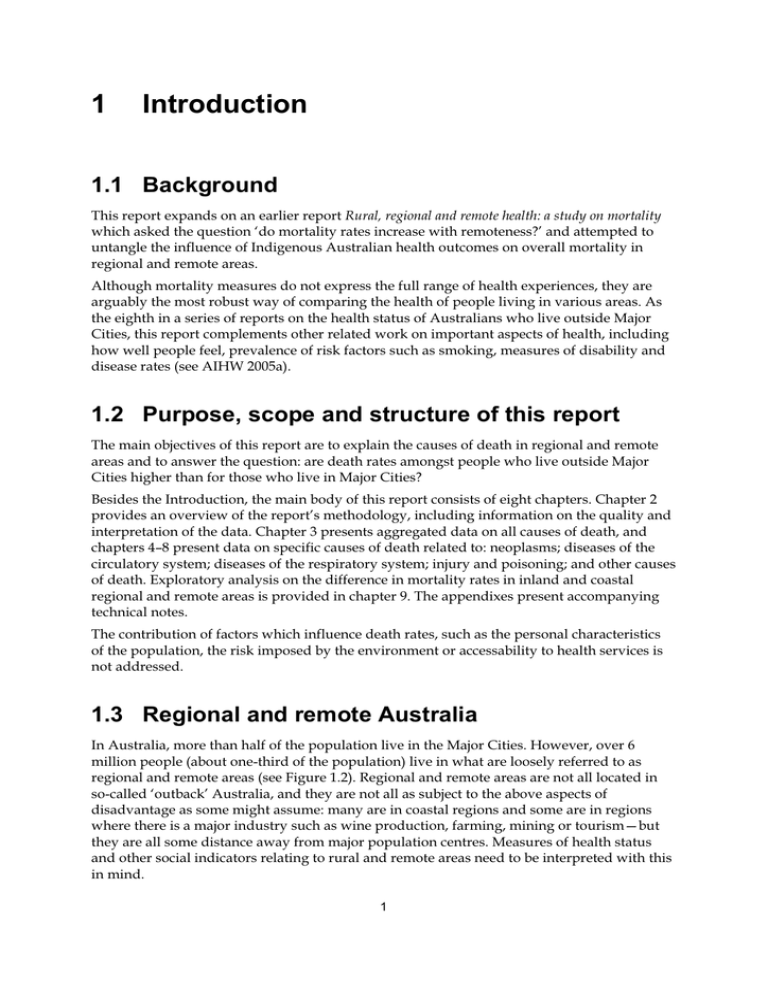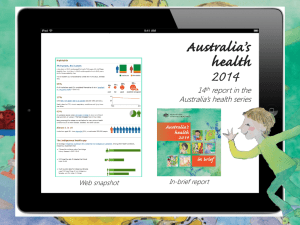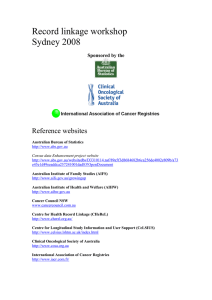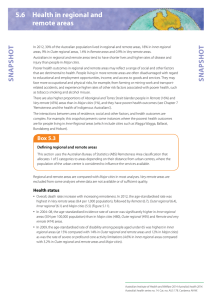Rural, regional and remote health: a study on mortality
advertisement

1 Introduction 1.1 Background This report expands on an earlier report Rural, regional and remote health: a study on mortality which asked the question ‘do mortality rates increase with remoteness?’ and attempted to untangle the influence of Indigenous Australian health outcomes on overall mortality in regional and remote areas. Although mortality measures do not express the full range of health experiences, they are arguably the most robust way of comparing the health of people living in various areas. As the eighth in a series of reports on the health status of Australians who live outside Major Cities, this report complements other related work on important aspects of health, including how well people feel, prevalence of risk factors such as smoking, measures of disability and disease rates (see AIHW 2005a). 1.2 Purpose, scope and structure of this report The main objectives of this report are to explain the causes of death in regional and remote areas and to answer the question: are death rates amongst people who live outside Major Cities higher than for those who live in Major Cities? Besides the Introduction, the main body of this report consists of eight chapters. Chapter 2 provides an overview of the report’s methodology, including information on the quality and interpretation of the data. Chapter 3 presents aggregated data on all causes of death, and chapters 4–8 present data on specific causes of death related to: neoplasms; diseases of the circulatory system; diseases of the respiratory system; injury and poisoning; and other causes of death. Exploratory analysis on the difference in mortality rates in inland and coastal regional and remote areas is provided in chapter 9. The appendixes present accompanying technical notes. The contribution of factors which influence death rates, such as the personal characteristics of the population, the risk imposed by the environment or accessability to health services is not addressed. 1.3 Regional and remote Australia In Australia, more than half of the population live in the Major Cities. However, over 6 million people (about one-third of the population) live in what are loosely referred to as regional and remote areas (see Figure 1.2). Regional and remote areas are not all located in so-called ‘outback’ Australia, and they are not all as subject to the above aspects of disadvantage as some might assume: many are in coastal regions and some are in regions where there is a major industry such as wine production, farming, mining or tourism—but they are all some distance away from major population centres. Measures of health status and other social indicators relating to rural and remote areas need to be interpreted with this in mind. 1 Geographic classification The Australian Bureau of Statistics (ABS) Australian Standard Geographical Classification (ASGC) Remoteness Areas classification (see Figure 1.1) has been selected as the geographic basis for reporting in this report. The ASGC Remoteness classification was developed by the ABS and was based on ARIA+, which was developed earlier by the National Key Centre for the Social Applications of Geographic Information Systems (GISCA) (ABS 2001a). In figures and tables throughout this report, Major Cities, Inner Regional, Outer Regional, Remote and Very Remote categories have been abbreviated as MC, IR, OR, R and VR. For more information on the various remoteness classifications please refer to the AIHW publication Rural, regional and remote health: a guide to remoteness classifications (AIHW 2004a). Characteristics of regional and remote populations Although the most visually obvious component of the economy in regional and remote areas is agriculture, the majority of people in these areas derive their income from other industry sectors (Table 1.1). Levels of income and education are lower in regional and remote areas than in Major Cities. In 2001, over half (55%) of people living in Very Remote areas were classified as being amongst the most disadvantaged people in Australia, and 2% were amongst the least disadvantaged. This compares poorly with those living in Major Cities, where only one-fifth were amongst the most disadvantaged, and just over one-third (34%) were amongst the least disadvantaged. 2 Figure 1.1: Remoteness Areas of Australia Source: ABS. 3 Table 1.1: Indigenous Australian and total populations, and selected characteristics within each ASGC Remoteness Area, 2001 Factor MC IR Percentage of: OR R VR Australia Per cent the national population living in each area 66 21 10 2 1 100 the Indigenous Australian population living in each area 30 20 23 9 18 100 1 2 5 12 45 2 <1 4 11 20 16 3 adults employed in other industry sectors 58 50 46 45 44 55 adults not in the workforce or unemployed 41 46 43 35 39 42 the population in each area who are Indigenous Australian adults employed in primary production (a) and mining people living in areas classified as being in the (b) (1996) 34 14 8 10 2 26 (b) (1996) 20 28 33 26 53 24 39 26 23 12 10 33 39 27 24 13 21 34 81 39 34 30 20 49 –least disadvantaged national SEIFA quartile –most disadvantaged national SEIFA quartile (c) youth starting tertiary study (c) non-Indigenous Australian youth starting tertiary study reticulated water supplies adequately fluoridated (d) Costs (average) Dollars Monthly mortgage 985 813 775 786 605 926 Weekly rent 206 155 154 148 122 189 (a) Primary production includes agriculture, forestry and fishing. (b) The percentages for SEIFA (Socioeconomic Indexes for Areas) relate to the percentage of the population in each area who lived in Census collectors districts that were among the 25% least disadvantaged, and the 25% most disadvantaged in Australia, in 1996. (c) The percentage commencing tertiary (university and TAFE) study is the apparent percentage of 17-20 year olds from each area that commenced tertiary study in 2001. Limited accuracy of the Indigenous Australian identifier cautions against regional reporting for Indigenous Australians. Nationally, 10% of Indigenous Australians of this age commenced tertiary study. (d) Fluoride data relate to a rolling survey. Some of the data may be up to 10 years old and do not relate specifically to 2001. Source: AIHW population database; AIHW 2005a. 4 About 25% and 10%, respectively, of 17–20 year olds from regional and remote areas commenced university or TAFE in 2001, compared with almost 40% of those from Major Cities (Table 1.2). The cost of housing in regional and remote areas tends to be, respectively, 75% and 65% of housing costs in Major Cities (Table 1.2), but other costs are higher. For example, the costs of food and petrol increase with increasing remoteness, so that in Very Remote areas they are respectively about 15–20% and 10% more expensive than in Major Cities (AIHW 2005a). Compared with people in Major Cities, those living elsewhere are more likely to be smokers, to drink alcohol in hazardous quantities, to be overweight or obese and to be physically inactive (AIHW 2005a). Also, people living outside Major Cities, particularly those living in remote areas, are more likely to be Indigenous Australian. Australia’s Indigenous population is disadvantaged compared to other Australians in almost all important areas of social concern (Table 1.2): their participation in education and levels of educational attainment are lower than the rest of the population; their labour force participation is lower and their unemployment rate higher; and their infant mortality rate is much higher and life expectancy much lower than the rest of the population (ABS & AIHW 2005). Other measures of their health reflect a similar pattern. Table 1.2: Comparison of selected characteristics of Indigenous Australians and non-Indigenous Australians Indigenous Australians Non-Indigenous Australians Percentage of 18–64 year olds unemployed (2002) 20% 6% Percentage older than 17 years who had completed Year 12 (2002) 19% 44% 5% 21% Median equivalised gross weekly income for people older than 17 years (2002) $394 $665 Own or purchasing own home (2002) 27% 73% Characteristic Percentage older than 24 years possessing bachelor degree or higher (2002) Source: ABS & AIHW 2005. Regional and remote environments The environment outside Major Cities is frequently stereotyped as ‘outback’, sparsely populated, hot, dry, populated by farmers, and isolated from population centres. In reality it is extremely diverse. Non-metropolitan populations can live in coastal or inland areas, within commuting distance of Major Cities, in mixed farming or extensive grazing areas, or in areas visually dominated by forestry, fishing, mining or tourism. Many areas outside Major Cities, predominantly on the coast, attract older people in retirement. Many of the occupations in regional and remote areas (for example, mining, transport, forestry, commercial fishing and farming) entail higher levels of risk than other occupations (AIHW: Strong et al. 1998). Also, large travel distances, higher speeds and animals on the road, for example, can increase risks for drivers and their passengers. Greater distances for recovery of those injured in 5 accidents or who become acutely ill (such as a heart attack) would be expected to increase the risk of death for people living in regional and remote areas. About 35% and 25% of reticulated water supplies in regional and remote areas respectively were considered to be adequately fluoridated compared with 80% in Major Cities (Table 1.1). Health services in regional and remote areas People living in regional and remote areas tend to have lower levels of access to health services (AIHW: Strong et al. 1998). Despite this, immunisation rates for children under 2 years in 2002 appeared similar to, or only slightly lower than, those in Major Cities, and rates of breast cancer and cervical screening in 2001 appeared higher than in Major Cities (AIHW 2005a). There were more hospital beds per capita in regional and remote areas in 2002–03 (respectively, three beds and five beds per 1,000 residents) than in Major Cities (2.5 beds per 1000 residents). Compared with Major Cities, hospitals in regional and remote areas were less likely to be accredited under a national accreditation scheme, and tended to be a lot smaller. Many hospitals outside Major Cities had fewer than 30 beds, but about 30 had between 100 and 300 beds (AIHW 2005a). There were differences in the rate at which people from Major Cities, regional and remote areas were admitted to hospital for a range of surgical procedures in 2002–03. Noticeably, the rate of admission for coronary artery bypass graft surgery and coronary angioplasty was lower for residents of regional and especially remote areas than for those in Major Cities. This contrasts with the higher death rates due to coronary heart disease in these areas. Rates of surgical procedure are likely to be affected by issues such as need and access, both physical and financial. The supply of health workers typically declines with remoteness (Table 1.3). 6 Table 1.3: Supply of health workers, by ASGC Remoteness Area, 2001–02 Occupation MC IR OR R VR Number per 100,000 population GPs 118 92 85 76 81 Specialists 108 48 30 16 7 Registered nurses 886 836 753 731 756 Enrolled nurses 172 273 303 303 200 Pharmacists 82 63 52 37 28 Physiotherapists 62 37 32 38 14 Podiatrists 11 9 4 4 2 Note: ‘GPs’ includes general practitioners and other primary care medical practitioners. Source: AIHW Labour Force Surveys. However, health workers in regional and especially remote areas tend to work longer hours than those in Major Cities. For example, in 2001, the weekly hours worked by GPs in regional, Remote and Very Remote areas were 10%, 15% and 26% longer than those in Major Cities (AIHW 2005a). This tends to partly compensate for the shortfall in the numbers of health workers in these areas, but, on the downside, longer working hours could impose additional strain on these workers, with resultant difficulties retaining staff in these areas in the longer term. Those who live away from Major Cities and for whom access to health services is restricted may be disadvantaged because of different access to: • preventive services such as immunisation and information allowing healthy life choices • health management and monitoring • specialist surgery and medical care • emergency care, for example, ambulance • rehabilitation services after medical or surgical intervention • aged care services. Demography of regional and remote populations In 2001, the majority (66%) of the Australian population lived in Major Cities. Of the remainder, 21% and 10% lived in Inner and Outer Regional areas, while 2% and 1% lived in Remote and Very Remote areas (Figure 1.2 and Table 1.4). Non-metropolitan areas include not only inland agricultural and remote areas, but also coastal areas. In fact, of the people who live outside the major cities, but not in remote areas, just under 50% live within 80 km of the coast (Garnaut et al. 2001). The ASGC Remoteness structure has been used in this description of regional and remote demography. Additional demographic data are provided in Appendix C. Mortality differences in coastal and inland areas have been described in chapter 9. Details of the coastal and inland populations are provided in the introduction to this chapter. 7 2 1 10 Major Cities Inner Regional 21 Outer Regional Remote Very Remote 66 Source: AIHW population database, based on Statistical Local Area (SLA) resident population estimates compiled by ABS. Figure 1.2: Population distribution in Australia, by ASGC Remoteness Area, 2001 (per cent) Table 1.4: Indigenous Australian and total populations within each ASGC Remoteness Area, 2001 Population MC IR OR R VR Total ‘000 Indigenous Australian Total Males 68 46 52 20 41 227 Females 71 46 54 20 40 231 Persons 138 93 106 40 81 458 Males 6,344 1,995 1,025 172 95 9,631 Females 6,527 2,030 989 153 83 9,783 Persons 12,871 4,026 2,014 324 179 19,413 Per cent Indigenous Australian % of regional population 1.0 2.0 5.0 12.0 45.0 2.0 % of national Indigenous Australian population 30.0 20.0 23.0 9.0 18.0 100.0 66.0 21.0 10.0 2.0 1.0 100.0 Total population % of national population Source: AIHW population database, based on SLA resident population estimates compiled by ABS. 8 The population of regional areas is smaller than that in Major Cities, but still substantial; the population in remote areas is very small in comparison. The percentage of the population who are Indigenous Australian varies substantially with remoteness; 1% of the population in Major Cities are Indigenous Australian, 2–5% are Indigenous Australian in regional areas, rising to 12% in Remote areas and 45% in Very Remote areas (Table 1.4). As well as these differences, there are substantial differences in the age and sex structure of the populations (Figure 1.3). In the Australian population, there are slightly more males than females; only in older age does the situation change as females outlive their male counterparts. However, in Remote (and especially Very Remote) areas, the number of males is substantially greater than the number of females (Table 1.5), with the numbers of males and females tending to become similar in old age. Per cent aged 0–14 years, 2001 Males Per cent aged 15–24 years, 2001 20 Males 16 16 Females 12 12 8 8 4 4 20 Females 0 0 MC IR OR R Per cent aged 25–44 years, 2001 MC VR Males Females IR OR R VR Per cent aged 45–64 years, 2001 20 Males 16 16 Females 12 12 8 8 4 4 20 0 0 MC IR OR R MC VR IR OR R VR Per cent aged 75+, 2001 Per cent aged 65–74 years, 2001 20 Males 20 Males 16 Females 16 Females 12 12 8 8 4 4 0 0 MC IR OR R MC VR IR Note: Percentage for males and females for each graph should add to 100. Source: AIHW population database based on SLA resident population estimates compiled by ABS. Figure 1.3: Age distribution, by ASGC Remoteness Area, 2001 9 OR R VR Table 1.5: Male to female population ratio, by ASGC Remoteness Area, 2001 MC IR OR R VR Total Ratio Non-Indigenous Australian 0.97 0.98 1.04 1.14 1.28 0.98 Indigenous Australian 0.96 1.00 0.98 1.01 1.01 0.99 Total persons 0.97 0.98 1.04 1.12 1.15 0.98 Source: AIHW population database, based on SLA resident population estimates compiled by ABS. In remote areas, there are proportionally more children, people aged 15–24 years and to a lesser extent people aged 25–44 years, than there are in Major Cities (Figure 1.4). There are proportionally fewer people older than 44 years, and substantially fewer people older than 65 years in Remote areas. In regional areas the proportion of people in each age group is similar to that in Major Cities, with the exception that there are proportionally more children, but fewer people aged 25–44 years. 12 10 MC IR Per cent 8 VR 6 4 2 85 + 10 –1 4 15 –1 9 20 –2 4 25 –2 9 30 –3 4 35 –3 9 40 –4 4 45 –4 9 50 –5 4 55 –5 9 60 –6 4 65 –6 9 70 –7 4 75 –7 9 80 –8 4 5– 9 0– 4 0 Age (years) Source: AIHW population database, based on SLA resident population estimates compiled by ABS. Figure 1.4: Age distribution for persons living in Major Cities, Inner Regional and Very Remote areas, 2001 10



